Armed Conflicts around the World
- the Excessive and Destabilizing Accumulation and Transfer of Small Arms and Light Weapons -
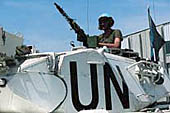
The UN Protection Force (UNPROFOR) in Bosnia and Herzegovina, 1994.
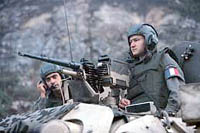
The UN Protection Force (UNPROFOR) in Bosnia and Herzegovina, 1994.
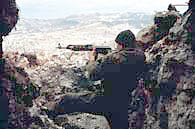
A Soldier with a weapon, 1994.
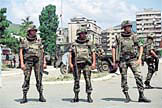
The NATO force in Kosovo, 1999.
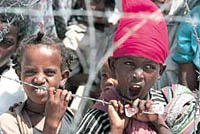
Children suffering from a conflict in an African country.

Soldiers with small arms, 1996.

A Soldier on patrol, 1995.
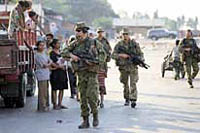
Soldiers on patrol in East Timor, 1999.
Although the likelihood of large-scale international armed conflicts in the current post-cold-war world seems to be receding, smaller ethnic confrontations and civil war have become more common, and the huge number of small arms and light weapons used in them constitutes a new threat to peace. The transfer-especially the illicit trafficking-of small arms and light weapons is growing increasingly frequent.
In Europe
The weakening or even collapse of state structures, and in particular the dissolution of the Soviet Union, has led to a greater availability of small arms and light weapons which are outside state control in some parts of Europe.
- Bosnia and Herzegovina 1992-95 (90,000)
- Yugoslavia 1998-99 (15,000)
- Albania 1997 (2,000)
- Russian Federation 1994-96 (35,000), 1999-
- Other conflicts in Europe
- Moldova 1990-92
- Azerbaijan, Armenia 1992-94 (22,000)
- Georgia 1989-96, 1992-94
In Africa
The uncontrolled availability of small arms and light weapons is not only fuelling various internal conflicts but is also exacerbating violence and criminality. This undermines the state's ability to govern effectively, thereby threatening the stability and security necessary for socio-economic development.
- Algeria 1992- (100,000)
- Western Sahara 1975-88
- Mali 1989-94 (2,000)
- Sierra Leone 1991-99 (40,000)
- Liberia 1989-96 (150,000)
- Chad 1980-94 (13,000), 1994- (1,000)
- Ethiopia, Eritrea 1998- (16,000)
- Sudan 1983- (50,000)
- Democratic Republic of the Congo 1996- (84,000), 1997- (5,000)
- Rwanda 1990- (811,000)
- Burundi 1993- (206,000)
- Angola 1975- (15,000)
- Somalia 1991- (355,000)
- Other conflicts in Africa
- Niger 1991-96
- Ethiopia 1997 (2,000)
- The Ethiopian-Sudanese border 1995 (5,000)
- Guinea-Bissau 1998-1999 (2,000)
- Gambia 1998- (1,000)
- The Nigerian-Cameroon border 1994-95 (5,000)
- Republic of the Congo 1998- (12,000)
- Mozambique 1976-92 (50,000)
- The Sudanese-Ugandan border 1995- (1,000)
- Uganda 1993- (3,000)
- Djibouti 1993-94 (1,000)
- Lesotho 1998-
In the Middle East
- Lebanon 1978-, 1975-90
- Turkey 1984- (over 30,000)
- Iran-Iraq 1979- (15,000), 1980-88 (500,000), 1988- (60,000)
- Kuwait 1990-91 (20,000)
- Cyprus 1974- (5,000)
- Other conflicts in the Middle East
- Yemen 1986-87 (11,000), 1994 (7,000)
- Israel 1967 (983), 1973 (2,838)
- Iran 1979 (3,000)
- Iraq 1991- (31,000)
- Jordan 1967 (700)
- Egypt 1967 (3,000), 1973 (5,000)
- Syria 1967 (600), 1973 (3,100)
In Asia and Oceania
- Tajikistan 1992-97 (51,000)
- Afghanistan 1992- (66,000)
- Cambodia 1970-75 (156,000), 1975-78 (1,000,000), 1997-98 (1,000)
- Philippines 1968-97 (75,000)
- Indonesia 1975-99 (200,000)
- In South Asia
During the war in Afghanistan from 1979 to 1988, both sides in the cold war exported large quantities of both major conventional weapons and small arms and light weapons into the region.- India-Pakistan 1989- (22,000)
- Sri Lanka 1983- (58,000)
- Other conflicts in Asia and Oceania
- Bangladesh 1982-98 (3,000)
- Myanmar 1985- (9,000)
- Papua New Guinea 1988-98
- Vietnam 1965-75 (2,000,000)
In Latin America
- Colombia 1963- (44,000)
- Peru 1981-95 (30,000)
- Chile 1973 (5,000), 1974 (20,000)
- In Central America
Large numbers of small arms and light weapons, which are still in circulation, remain available for acquisition by criminal gangs and armed groups, despite the encouraging results from several programmes for the collection and destruction of arms.- Mexico 1994- (5,000)
- Guatemala 1968-1996 (150,000)
- El Salvador 1979-95 (75,000)
- Nicaragua 1978-79 (50,000), 1981-88 (30,000)
- Other conflicts in Latin America
- Venezuela 1994-95
- Ecuador 1995-98
- Haiti 1991-95 (3,000)
Note: The figures in parentheses show the fatalities in conflicts.
Source: The Military Balance 1999-2000, etc.
Back to Index
